If FCC Can't or Won't Deal with FM Pirates, Perhaps It Should Have a Candid Conversation With FAA on Aviation Safety?
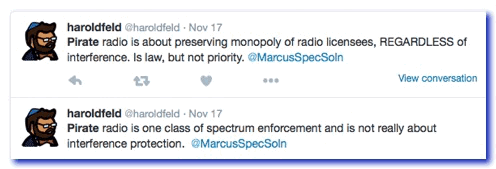
I have known Harold Feld, Public Knowledge's Senior Vice President, for a long time and agree with him on many issues. He has even been a past client. But the above Twitter exchange indicates a not unusual viewpoint in the spectrum policy area and clearly was an undercurrent in the recent consultant's report that rationalized decimating the FCC's spectrum enforcement resources.
Notwithstanding vague promises made to NAB it is pretty clear that broadcast pirate enforcement will be a low priority for the new "modernized" field enforcement at FCC. Pirate broadcasting is often intermittent and at odd hours, requiring both staff overtime and travel, two things that are very scarce at today's underfunded FCC. New equipment designed to decrease necessary staff time would also be helpful, but equipment money is also very scarce.
So let me address the safety implications of pirate broadcasting, rather than view it solely as just an economic inconvenience to incumbent broadcasters. Pirate broadcasters distract audiences and also sometimes even carry paid ads!
But all properly licensed FM stations are subject to technical rules also. While some of them may be about "preserving monopoly of radio licensees", many also deal with preventing interference to other non broadcast radio systems. (The ongoing saga of interference from certain licensed FM stations to 700 MHz LTE base stations due to a regulatory loophole (along with FCC distraction on other issues) is a concrete example that each radio service does not live in a totally independent silo from other services!
It is doubtful that all pirate FM stations buy transmitters that meet all Part 73 technical standards with respect to out-of-band emissions and harmonics. Thus there is a real risk of interference to other radio services without some reasonable check and balances.
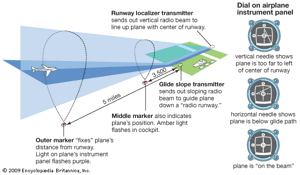
FM stations that are properly licensed use frequencies, powers, and locations that have been reviewed by FAA during the application process to make sure they do not pose a new inference risk to ILS receivers in aircraft. Pirate radios are very unlikely to check with FAA. (FAA's Airspace Analysis Model computer program that does the analysis is publicly available so they might check, but I doubt it.) While it is generally assumed that intermodulation interference can only occur when there are 2 strong signals present with the correct mathematical relationship with the victim signal, that is not literally correct. As shown in ITU-R Recommendation SM.1009-1 the interference power generated in the receiver by the inevitable nonlinearities is the weighted sum of the power of the 2 FM frequencies that have the correct relationship with the ILS frequency. (This is called Type B interference in the jargon of ITU-R.)
If one of these FM broadcast band frequencies comes from full power FM station and is very large at the location of the ILS receiver in the air, only a negligible amount of power at the other frequency is needed to cause interference if they have a certain mathematical relationship. While the math is clear, it is counterintuitive that a low power signal could cause such interference. Many years ago while I was working at FCC on this issue and the main contact with FAA on it I asked them to demonstrate this phenomenon which they kindly did for me and several other FCC officials at their Technical Center in Atlantic City.
Thus a modest power pirate FM could have the right location, power, and frequencies to cause Type B interference to the safety critical ILS signal.
Like FCC, FAA is not a perfect agency. Almost every other aviation regulator in the world limits the likelihood of this interference by both addressing the issue of FM station power, frequency, and location near airports and by mandating receiver immunity standards prescribed in ICAO Annex 10 to the Convention on International Civil Aviation, Volume I – Radio Navigation Aids, Section 3.1.4 Interference immunity performance for ILS localizer receiving systems (2006). However, as we have discussed earlier, FAA has refused to implement their standards for US aircraft in domestic service and has blocked FCC implementation of them. Thus the FAA's Airspace Analysis Model that predicts interference assumes that receivers more vulnerable than the ICAO standards are in use. But as pirate radio stations proliferate without effective enforcement there is a real risk that one of them might just land at a power, frequency, location triple that poses a threat to aviation safety but is not addressed since pirates don't have to deal with spectrum regulations!
If this is the new reality of "field modernization" then I urge FCC to have a pragmatic discussion with FAA,who were consulted on aspects of the consultants study but probably not this one, that FM pirates are a low priority and they might want to increate the immunity of the US air fleet (foreign aircraft already comply) to this type of interference by implementing the 2006 ICAO immunity standard.
NY Times: "The F.A.A. has no proof that electronic devices can harm a plane’s avionics, but it still perpetuates such claims" "Dealing with the F.A.A. on this topic is like arguing with a stubborn teenager"
Readers may recall that SpectrumTalk has repeatedly talked about the FAA’s renegade role in spectrum management: apparently not happy that Congress has split spectrum management between FCC and NTIA (with some international issues at State), FAA likes to impose itself as another coequal player in national spectrum management. Meanwhile NTIA for decades, glowing in its power derived from Section 305 of the Communications Act, has lacked the moral backbone and institutional authority to keep FAA in line with respect to national spectrum policy issues.
Recently the NY Times published the article whose heading is shown above. Here is a quote:
Dealing with the F.A.A. on this topic is like arguing with a stubborn teenager. The agency has no proof that electronic devices can harm a plane’s avionics, but it still perpetuates such claims, spreading irrational fear among millions of fliers.
A year ago, when I first asked Les Dorr, a spokesman for the F.A.A., why the rule existed, he said the agency was being cautious because there was no proof that device use was completely safe. He also said it was because passengers needed to pay attention during takeoff.
When I asked why I can read a printed book but not a digital one, the agency changed its reasoning. I was told by another F.A.A. representative that it was because an iPad or Kindle could put out enough electromagnetic emissions to disrupt the flight. Yet a few weeks later, the F.A.A. proudly announced that pilots could now use iPads in the cockpit instead of paper flight manuals.
Now FAA likes to say that the problem is “aggregation” - the impact of many emitters operating at the same time. But the real problem of aggregation comes from faulty technical analysis of the spectrum problems.
While aggregation can happen in some scenarios, e.g. terrestrial transmitters operating cochannel with a satellite uplink, real multipath propagation - as happens in most scenarios int he real world - results in lognormal propagation path losses in one or two emitters dominating the interference scenario and the others having no impact.
The Times points out that In December both FCC Chairman Genachowski and Senator Claire McCaskill (D-MO) both urged FAA to be more rational with respect to use of devices on aircraft. Sen. McCaskill even wrote that she was “prepared to pursue legislative solutions should progress be made too slowly.” She said she was urging the agency to embrace the use of electronics, including laptop computers, e-readers, smartphones and other devices, “during the full duration of a flight.”
“The current rules are inconvenient to travelers, don’t make sense and lack a scientific basis,” she said in the letter. “Airline employees have the incredibly important job of keeping us safe in the air. Their efforts are better spent worrying about rules that actually accomplish that goal.”
FAA likes to say that it is only obsessed with safety - an admirable goal if true. However, the sordid history of the FM/ILS affair also shows that FAA is just as concerned about the proprietary interests of “its constituency” - the airlines and AOPA - than it is of safety issues. Also the FAA’s bizarre 2006 NPRM, never coordinated with either FCC or NTIA, that proposed giving the agency veto power over both federal and nonfederal spectrum use in dozens of bands shows a fundamental misunderstanding of the public interest in spectrum.
So kudos to NY Times for their great coverage of this issue. When will NTIA and Congress pressure FAA to start acting more rationally on spectrum matters?
Silicon Flatirons Spectrum Conference Papers Available
Also Paper on FM/ILS Controversy
In U.S. Spectrum Policy: The Way Forward, Kathryn C. Brown and Charla Rath
Beyond Kolkata: Delivering on the Fundamental Goals of the Communications Act, Michele C. Farquhar
Not A Zero Sum Game - Why Objections To The PCAST Report Make No Sense, Harold Feld
The Stunted Public Interest Vocabulary in the Broadcast Spectrum Auction, Ellen P. Goodman
U.S. Spectrum Policy - When the Rubber Meets the Road, Kathleen Ham and Sara Leibman
The Promise and Problems of Strategic Plans, Charles L. Jackson
The Promise and Problems of Strategic Plans: From the Spectrum Policy Task Force to the PCAST Report, Michael J. Marcus
The View Ahead: Technology Opportunities, Preston Marshall
The Wireless Data Demand: Technology and Spectrum Implications, Edward G. Tiedemann, Jr.
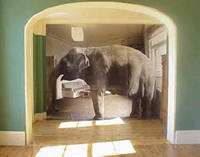
However, there are lessons to be learned from this long simmering dispute: Receiver standards often have economic externalities - those who pay the cost are not the same as those who get the benefits. If we do not recognize this issue and find a way to deal with them there will be no progression this area.
Instrument Landing System Receiver Standards:
A Case Study of Receiver Regulation and Its Difficulties
The Instrument Landing System (ILS), used worldwide by aviation users, has two bands, one of which is just above the FM broadcast band at 108.1 -112 MHz. This safety-related landing system has been standardized by both FAA and ICAO, the ITU’s aviation counterpart. Unfortunately the adjacency to the FM broadcast band results in a possible vulnerability to receiver-generated intermodulation interference. This vulnerability was confirmed in FCC Lab measurements.(1 2) FAA and FCC have had a long standing disagreement on the best public policy approach to prevent such interference and NTIA has generally taken a neutral role with respect to this issue and has not been directly involved.
ICAO adopted immunity standards for ILS receivers that were effective international in 1998. (Those stands are mentioned by NTIA on p. 29 of its receiver standards compilation; The specifics of the ICAO regulation can be found in this document from the South African FAA counterpart.) FAA has implemented the ICAO regulation but still allows use of the previous generation of receivers and uses its powers under the Airways Facilities Act to threaten new or modified FM broadcast facilities for “hazard determinations” if they apply for a location, frequency, or power that would cause interference to the earlier generation receivers as projected by a FAA computer model that was not adopted in a “notice and comment” proceeding.
FCC proposed in 1993 to require only ICAO-complaint receivers in all US aircraft after the 1998 effectiveness date. (the NPRM was in response to this petition from broadcast interests.) This NPRM was opposed by aviation interests that felt they should not be burdened with replacing receivers in order to facilitate the use of broadcast spectrum (1 2 3). FCC took no further action on this NPRM until the docket was closed in a 2002 housekeeping action for being “stale”.
It is generally felt that airliners and corporate jets are not affected by this issue since, for practical purposes, they must be equipped to fly outside the US and therefore have ICAO-complaint receivers. However, there are small general aviation aircraft that are not actually required to be ILS-equipped that may well have the previous generation receivers and their trade association, AOPA, has vociferously objected to a mandated upgrade. (It is thought that all ILS receivers made anywhere in the past 20 years comply with the ICAO standard so that any noncompliant receiver in present use is likely 20+ years old.)
This receiver standard issue is a classic economic externality. The aviation users who would incur the cost of a new receiver would get no direct benefit. The benefits would accrue to broadcasters who could modify their facilities to better serve the public though power or siting changes and to the public that would receive addition FM stations if present FAA objections to some new allotments were dropped.
As in the GPS/LightSquared issue, this also falls squarely on the FCC/NTIA jurisdictional fault line, although complicated by the role of FAA and its partially overlapping jurisdiction.
Developing receiver standards is a technically complex issue. But in this case there is a specific international standard that was developed with participation of all affected parties. The US ambivalence towards receiver standards has left that standard in limbo in the US in the 2 decades since it was developed and has limited the utilization of FM broadcast spectrum in order to avoid putting any increased regulatory burdens on an ever decreasing number of small aircraft with obsolescent receivers that could not be used in most other countries.
It is not clear how this issue can ever be resolved due to the jurisdictional issues unless the Executive Branch takes a more holistic approach to such spectrum issues.
Partisanship and Spectrum Policy

Here is some of the coverage of a recent hearing of the Subcommittee on the GPS/LightSquared issue by our fellow bloggers at Ars Technica.
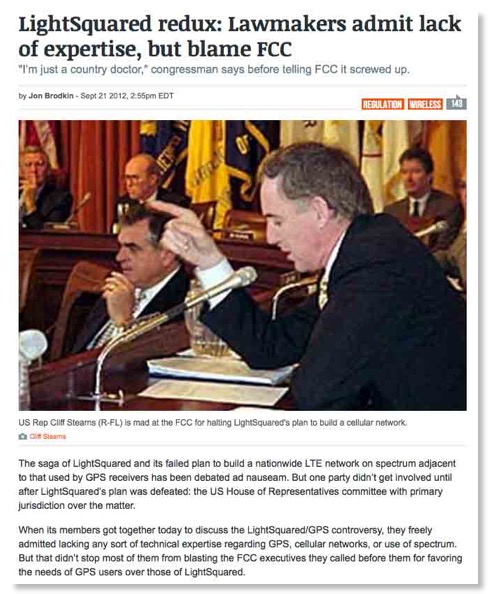
The hearing, video of which is available below, had the committee members chewing out my former colleagues International Bureau Chief Mindel De La Torre and OET Chief Julius Knapp, on why they halted LightSquare’s system. They repeated insisted on yes/no answers on questions that were complex and had not straightforward answers. Here is an example:
Rep. Stearns: “Each operator has the responsibility to stay in its lane, using your analogy, is that correct?”
De La Torre: "Yes."
Rep. Stearns: “When one operator veers into the adjacent lane, is it the responsibility of an operator to correct its course, or is it the role of the FCC to patrol the highway? Briefly."
De La Torre: “Really, what was happening here was…”
Rep. Stearns: “Isn’t it the responsibility of the operator to correct its course? Yes or no?”
De La Torre. “It’s a difficult question. That’s the question that's before us, and I think…”
Rep. Stearns: “Yes or no? I'm asking for a yes or no, to the best of your ability.”
De La Torre: “I think they do have a duty to respond…”
Rep. Stearns: “OK, I'm going to take that as a yes.”
One of the odder exchanges was reported by Ars Technica as:
US Rep. Brian Bilbray (R-CA), an avid boater, said he understands the importance of GPS for safely finding one’s way home. But, "on the flip side," he said, more spectrum devoted to iPhones can improve safety too. "Just as much as GPS is essential there are thousands of people offshore every day that would have a huge safety factor if they could pull up an iPhone, and from 200 miles offshore be able to call for emergency services," he said. "This has a safety issue going both ways."
Rep. Bilbray, conventional cell phones including iPhone, do not work and will never work from “200 miles offshore”. MSS systems like Iridium and the service offered by LightSquared’s presently operational MSS system (designed to share spectrum with their proposed but threatened terrestrial ATC system) do. It is ironic that what triggered the current imbroglio was LightSquared trying to offer cellphones that were terrestrial only as opposed to bulkier ones previously authorized by FCC that included both MSS and terrestrial(ATC) service.
Months before the Republicans of the Energy & Commerce Committee came late to the GPS/LS issue, their fellow Republicans on the House Armed Services Committee criticized FCC for the exact opposite reason: why did they ever consider authorizing LightSquared as opposed to kowtowing to GPS interests and their self-centered view of spectrum policy.
So House Republicans, which is it? Is the current FCC wrong for considering LightSquared at all or it is wrong for not defending them again GPS interests? Perhaps both reasons are good enough to bash the present FCC and by implication the White House? Note that there were multiple FCC decisions under Chmns. Powell and Martin that supported ATC and LightSquared and its predecessors and that GPS interests participated in those decisions without major complaints at the time.
On September 13th, the Committee’s Subcommittee on Communications and Technology dumped on NTIA at the behest of cellular interests.
This time NTIA’s Karl Nebbia was beat up by the subcommittee members who were really angry over the PCAST report that Karl probably personal dislikes but had to defend as part of his job. While the free trade press did not cover this event, Keystone Public Affairs has posted this summary.
In both September hearings the committee’s subcommittees were trying to make partisan hay out of US spectrum management issues. The reality is that there are major problems in our present spectrum policy decision making in the US as any longtime reader of this blog has read multiple times. The roots go back decades and are bipartisan in nature. What we really need to to keep spectrum policy bipartisan as it generally has been and work together to improve the process.
FAA and Passenger Electronics Use
Will the familiar warning for airline passengers to "discontinue the use of all portable electronic devices" become a relic of the past?
Perhaps.
By popular demand, the Federal Aviation Administration is forming a group to study policies governing the use of consumer electronics in the sky.
The review could lead to increased use of iPads, portable DVD players and other consumer electronics in aircraft cabins.
Note that the issue here is electronics other than cell phones. Use of cell phones in aircraft is banned by FCC because at high altitudes a cell phone will “see” and impact many cell sites. Thus it will use a large amount of cellular capacity.
FCC did consider allowing femtocell-like base stations in aircraft in Docket 04-435 , but rejected the idea after a tsunami of consumer opposition about the social impact of having someone in the next seat talking loudly (since cell phones have little or no sidetone to given user feedback on appropriate speech level).
Older readers will recall that until about 20 years ago FAA forbid all cell phone use on aircraft, even when the plane was stopped on the runway. FAA wraps itself in its “safety culture” and in pandering to its constituency, e.g. ATA (now actually A4A) and AOPA - but not the general public - to be as unaccountable as possible in some decisions. (Amusingly, FAA staffers routinely criticize FCC for being too close to its constituency.)
The oral traditional about the change about 20 years ago was that a key member of Congress with oversight authority over FAA was trapped on a plane at DCA’s runway for 2 hours without being able to use his cell phone. When he got back to his office he summoned the FAA Administrator and demanded a justification for the then existing rule on no cell phone use ever in aircraft. When the FAA Administrator finally demanded from his middle managers an explanation, he saw he “had no cards” and the present policy of limited cell phone use on the runway was quickly adopted.
As a service to SpectrumTalk readers, here is a link to the actual FAA “ Notice of policy; request for comments” on Passenger Use of Portable Electronic Devices on Board Aircraft .
DATES: Written comments must be received on or before October 30, 2012
Note that this document states “The FCC will be a key partner in this activity working collaboratively with the FAA, airlines, and the manufacturers to explore broader use of PEDS in flight.” I would like to believe this is true, but as someone with 2 awards from the FAA Administrator for helping FAA resolve critical safety problems, this statement does not ring true. Also, the inability of the FAA spokesman at the FCC Receiver workshop in March to even mentioned the longstanding FM/ILS disagreement between the 2 agencies shows that bilateral collegiality has a long way to go between these agencies. NTIA continues to turn a blind eye to such issues.
Danger FUD Attack!
The Bizarre Case of LightSquared and GPS
The Bizarre Case of LightSquared and GPS
FUD (fud) n. 1. a method of disparaging an opponent by avoiding the specifics of an issue and creating a smoke screen of “fear, uncertainty, and doubt”
The spectrum struggle of LightSquared to obtain permission to use its spectrum for terrestrial broadband use in addition to the mobile satellite use it is already licensed for looks like it will be a classic one at FCC, bringing back elements of previous epic struggles like Northpoint/MVDDS, UWB, AWS-3/M2Z, and PCS H block. These all involved a proposed new spectrum use that threatened incumbent users with possible interference.
To make matters worse, in 3 of the above cases the new entrant would also be competing with the incumbent, a combination sure to infuriate any incumbent with an FCBA directory at hand and the funds to wage a protracted legal battle. The fact that DirecTV was on “the auction block” during the Northpoint/MVDDS battle and T-Mobile was also during the AWS-3 battle meant that those two firms had extra incentive to assuage the fears of potential multibillion dollar buyers by waging a scorched earth policy before FCC. Now we see the GPS industry doing the same with respect to their neighbor LightSquared and NTIA and the military are joining in. The GPS industry is taking advantage of the “ex parte loophole” to lobby IRAC members and NTIA to press FCC off the public record.
(The 12/13/10 USGIC letter to NTIA is in the record of this proceeding only because an OET staffer mysteriously got a copy from NTIA and took the initiative to place it in the file. Had NTIA not sent a copy of the actual letter to the OET staffer, the content of this letter might never have become public. Why doesn’t NTIA reveal this outside lobbying clearly intended to influence FCC? Transparency is a big issue for the Department of Commerce, shouldn’t NTIA be a team player over there? This week Secretary Locke said in Brazil, “we hope the Brazilian government will continue its efforts to build a business climate with more transparency and a more consistent regulatory environment”. Let’s see how well NTIA can do in the transparency area!)

Speaking at the Air Force Association's Air Warfare Symposium in Orlando, Gen William Shelton says the 4G mobile broadband network in the works from LightSquared would spread 40,000 towers - and interference - across the US.
"Within three to five miles on the ground and within 12 miles in the air, GPS is jammed by those towers," Shelton says. "If we allow that system to be fielded and it does indeed jam GPS, think about the impact. We're hopeful we can find a solution, but physics being physics we don't see a solution right now. Where did these numbers come from? A lot of people think he went “hook, line, and sinker” for data from a report from Garmin, not exactly a high end GPS manufacturer. “Physics being physics” - a great sound bite, but does it belong in the policy deliberations here?
In this proceeding as well as the 4 mentioned above, the opponents of progress demonstrated that a poorly designed new system would cause interference to their system and then made the extrapolation that ANY such new system must cause interference no matter how it is designed! To make matters worse, Gen. Shelton and the GPS industry repeatedly use the term “jam”. Google now gets 175,000 hits on the terms “GPS”, “jam” and LightSquared”! Note that a recent joint USGIC/LightSquared joint filing uses the more objective and technically correct term “potential for overload interference/desensitization to GPS receivers, systems, and networks”.
To help spread FUD, several companies and organization have formed a group, Coalition to Save Our GPS (CSOG). In addition to GPS companies Garmin and Trimble, the group includes: the Aeronautical Repair Stations Association, Air Transport Association, Aircraft Owners and Pilots Association (AOPA), American Association of State Highway and Transportation Officials, American Rental Association, Associated Equipment Distributors, Association of Equipment Manufacturers, Case New Holland, Caterpillar Inc., Edison Electric Institute, Esri, General Aviation Manufacturers Association, Deere & Company, National Association of Manufacturers, and OmniSTAR.
Readers may recall that AOPA is the group that has successfully pressured FAA for 20 years not to adopt ICAO ILS receiver standards that prevent receiver-generated intermodulation because they would rather that the whole burden of preventing the problem be on the FM broadcast industry. These ILS receiver standards have been adopted in most other countries but would inconvenience AOPA members who might wish to use 20 year old ILS receivers and feel they have a constitutional right to use anything the FAA ever approved!
Let’s see what the spectrum in question looks like:
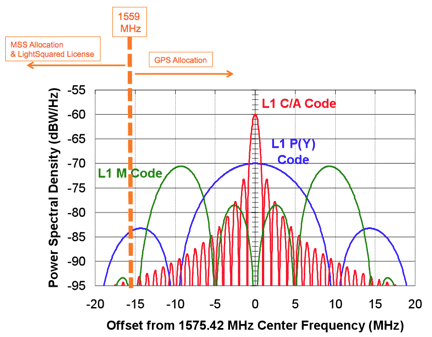
As can be seen, most of the GPS energy is in its allocated spectrum above 1559 MHz but the blue colored L1 P(Y) has some noticeable power below 1559 MHz. While the L1 C/A code is what is received in consumer GPS receivers, the P(Y) signal was intended only for military use and is often encrypted. The latest GPS satellites use the L1M code which stays within the allocation. As an excellent e-book from Trimble points out, “Because this code (P(Y)) modulates both the L1 and L2 carriers, some advanced civilian receivers can play sophisticated games with the two frequencies to help eliminate errors caused by the atmosphere”. Thus the sophisticated real-time kinematic (RTK) receivers with centimeter accuracy use a piece of Government spectrum that was not planned for civilian use; with NTIA-authorized transmitters but receivers that never went through the NTIA spectrum planning process. In addition, L1 consumer grade receivers with marginal filters in their front ends could be subject to overload interference/desensitization from unexpectedly strong adjacent channel signals.
The first problem is related to FCC and NTIA not paying enough attention to the fact that a large nongovernment community was using an NTIA authorized Government system in ways that were not planned. This latter problem is oddly similar to the PCS H block problem and the AWS-3/M2Z problem and deals with reasonable present and long term expectations for receiver filters. Normally in an exclusively government band like GPS’ this would have been decided by NTIA as part of its normal process, but the commercial products did not have to met the receiver specs filed at NTIA by the Air Force. An old saying in the spectrum management business is that “transmitters do not use spectrum, receivers do”. While FCC generally does not regulate receivers, NTIA does but commercial GPS receivers fell in the interagency gap.
As part of their FUD attack, the GPS community is stating conditions (demands?) for any outcome:
Further, the FCC's, and NTIA's, finding that "harmful interference concerns have been resolved" must mean "resolved to the satisfaction of pre-existing GPS providers and users.”
Resolution of interference has to be the obligation of LightSquared, not the extensive GPS user community of millions of citizens. LightSquared must bear the costs of preventing interference of any kind resulting from operations on LightSquared's frequencies. GPS users or providers should not have to bear any of the consequences of LightSquared's actions.
So according to their first point, “public interest” should no be longer the criteria for spectrum policy decisions. 77 years after the passage of the Communications Act we should designate certain spectrum users, in this case not even licensees, with veto power over certain spectrum decisions. I bet the whole NAB membership will be next in line for such veto power or be insulted if they don’t get it first!
In the second point it appears that as in the case of the aging ILS receivers that AOPA and FAA are protecting, any GPS receiver ever sold must be protected for the rest of its natural life. FCC is nearing the end of a 20 year transition of narrowbanding VHF and UHF land mobile spectrum. Would a 20 year transition for upgrading GPS receiver filters be slow enough be acceptable to CSOG? Since AOPA is involved, will they insist that spectrum efficiency wait until the last current model GPS dies a natural death as they have in the ILS case? Would groups like AOPA object to adjacent band signal rejection standards for new GPS units? Would that constitute the dread “bear(ing) any of the consequences of LightSquared decisions”? Are there any compensating public interest benefits of what LightSquared proposes in the eyes of CSOG?
Despite what Gen. Shelton says about “physics”, some of the building blocks of a solution are clear:
• LightSquared could carefully shape the beam and particularly the vertical pattern of their antennas to limit power flux density (pfd) on the ground and in the air. The alarmist Garmin report that Gen. Shelton appears to have based his statements on assumed 32 dBW EIRP for the LightSquared system and did not consider any beam shaping that would limit pfd on the ground or in the air. Thus it ignored all the lessons of the Northpoint/MVDDS controversy.
•The GPS community could switch to higher performance filters in their new receiver front ends. Such a switch is not painless but filter technology, not unlike digital semiconductor technology improves with time and will continue to improve.
•LightSquared could shaped their spectrum and stay away from the GPS lower edge in their initial implementation when they have fewer cell sites and hence need more power. The shape could change as the GPS receiver population improves with time and as increased cell site density decreases base station power requirements.
Meanwhile read for yourself what is happening. For procedural reasons this is not a docketed proceeding, but is on the obscure International Bureau Electronic Filing System (MyIBFS). Here is a direct link. MyIBFS was clearly not intended for this type of “food fight” and may collapse under the weight of the consumer comments CSOG is soliciting- it is already getting difficult to use for this issue. Fortunately MyIBFS is so user unfriendly that individuals probably can’t file directly and CSOG is asking consumers to e-mail a general FCC address which probably will be swamped.
Meanwhile, LightSquared and USGIC are meeting as directed by FCC to try to resolve their differences. FCC and the public get monthly views - on the chaotic MyIBFS site - of what is happening. It is sort of a negotiated rulemaking without the safeguards of the Negotiated Rulemaking Act. Negotiated rulemakings have never worked at FCC, but such 2 sided negotiations have had problems also. In the 1980s FCC told educational FM licensees to solve their power increase differences with adjacent band TV channel 6 licensees (another adjacent band power increase problem!) But the Commission had to fine tune the negotiated agreement, finding that agreements between the directly affected parties do not always reflect the overall public interest.
UPDATE
On March 25 the Deputy Secretaries of DoD and DOT wrote to Chmn. Genachowski on the public record - since unlike NTIA they do not “share jurisdiction” with FCC. They complain that their agencies are not included “in the initial workplan or its key milestones”. They say “we are concerned with this lack of inclusiveness regarding input from federal stakeholders”.
Wow! Given a choice between a seat - or 2 seats in this case - on IRAC or being invited to USGIC/LightSquared powwows I know which I would choose! IRAC members get drafts of FCC decisions that no other outsider sees and generally can make nonnegotiable demands on FCC as a price for coordination. Notwithstanding the fancy language about NTIA’s role, NTIA almost always acts as the IRAC’s messenger/law firm and types the IRAC demands on Commerce Department letterhead for transmission to FCC.
On the other hand, the negotiated rulemaking approach above would avoid DoD and DOT being left out int he cold. But are DoD and DOT willing to stop using the “NTIA loophole” to funnel private firms issues to FCC through NTIA off the public record? Will DoD and DOT commit to full transparency in this proceeding except for valid national security issues?
NEW UPDATE
FCC has now place the comments in docket 11-109 so they are available by way of ECFS. Despite its many quirks, ECFS has much better search facilities than the obscure MyIBFS which clearly was not intended for such large proceedings.

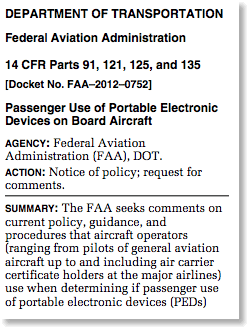
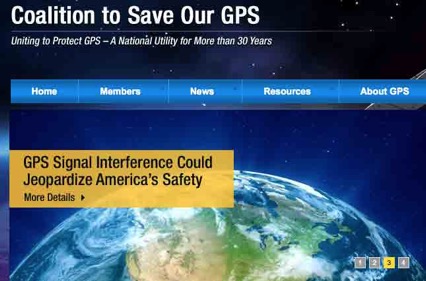



![Validate my RSS feed [Valid RSS]](valid-rss-rogers.png)

